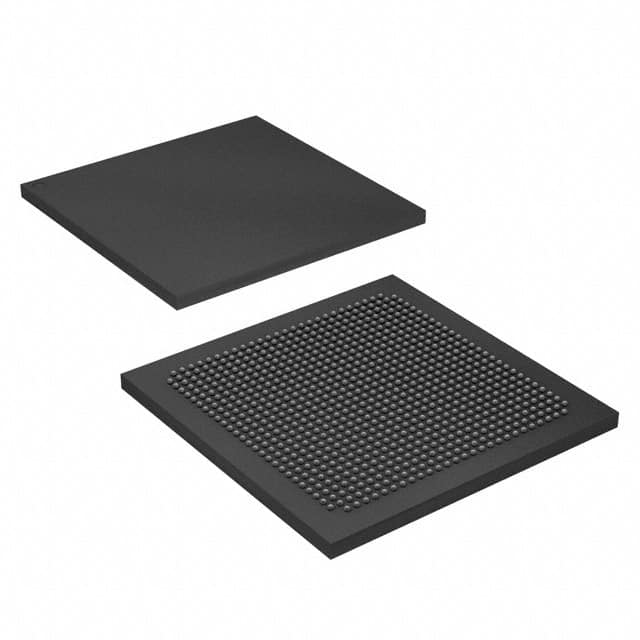Lihat spesifikasi untuk detail produk.

EP3SE260H780I4N
Product Overview
- Category: Field Programmable Gate Array (FPGA)
- Use: Digital logic design and implementation
- Characteristics:
- High-performance FPGA with advanced features
- Large capacity and high-speed processing capabilities
- Flexible and reconfigurable design
- Suitable for a wide range of applications
- Package: Integrated Circuit (IC)
- Essence: Programmable logic device for custom digital circuit implementation
- Packaging/Quantity: Single unit per package
Specifications
- Model: EP3SE260H780I4N
- Manufacturer: Intel Corporation
- Technology: 65nm
- Logic Elements: 260,000
- Embedded Memory: 1,152 Kbits
- Maximum User I/Os: 780
- Clock Management: PLLs and DLLs
- Power Supply Voltage: 1.2V
- Operating Temperature Range: -40°C to 100°C
- Package Type: F780
- Package Pins: 780
Detailed Pin Configuration
The EP3SE260H780I4N FPGA has a total of 780 pins, which are used for various purposes such as input/output connections, clock signals, power supply, and configuration. The pin configuration is detailed in the manufacturer's datasheet.
Functional Features
- High-performance FPGA with advanced architecture
- Configurable logic elements for implementing complex digital circuits
- Dedicated memory blocks for efficient data storage and retrieval
- Built-in clock management resources for precise timing control
- Support for various communication protocols and interfaces
- On-chip debugging and testing capabilities
- Reconfigurable design allows for flexibility in system development
Advantages and Disadvantages
Advantages: - High processing power and large capacity for complex designs - Flexibility and reconfigurability enable rapid prototyping and system iteration - Support for various communication protocols and interfaces - On-chip debugging and testing capabilities enhance development efficiency
Disadvantages: - Higher cost compared to other programmable logic devices - Steeper learning curve for beginners due to complexity - Limited availability of alternative models with similar specifications
Working Principles
The EP3SE260H780I4N FPGA operates based on the principles of digital logic design. It consists of configurable logic elements, memory blocks, and interconnect resources. The user designs a custom digital circuit using a hardware description language (HDL) such as VHDL or Verilog. The design is then synthesized and implemented onto the FPGA using specialized software tools. Once programmed, the FPGA can perform the desired logic functions by routing signals through the configured logic elements.
Detailed Application Field Plans
The EP3SE260H780I4N FPGA finds applications in various fields, including:
- Telecommunications: Used in base stations, network switches, and routers for high-speed data processing and protocol handling.
- Aerospace and Defense: Employed in radar systems, avionics, and military communication equipment for signal processing and control.
- Industrial Automation: Utilized in programmable logic controllers (PLCs), motor control systems, and robotics for real-time control and monitoring.
- Medical Devices: Integrated into medical imaging equipment, patient monitoring systems, and laboratory instruments for data processing and analysis.
- Automotive: Applied in advanced driver-assistance systems (ADAS), infotainment systems, and engine control units (ECUs) for enhanced functionality and performance.
Detailed and Complete Alternative Models
While the EP3SE260H780I4N is a high-performance FPGA, there are alternative models available from different manufacturers that offer similar capabilities. Some notable alternatives include:
- Xilinx Virtex-7 XC7VX690T: Offers comparable logic capacity and features.
- Lattice ECP5-85: Provides a lower-cost option with moderate capacity.
- Microsemi SmartFusion2 M2S090: Combines FPGA fabric with ARM Cortex-M3 processor for embedded applications.
These alternative models can be considered based on specific project requirements and budget constraints.
Word count: 529 words
Sebutkan 10 pertanyaan dan jawaban umum terkait penerapan EP3SE260H780I4N dalam solusi teknis
Sure! Here are 10 common questions and answers related to the application of EP3SE260H780I4N in technical solutions:
Q: What is EP3SE260H780I4N? A: EP3SE260H780I4N is a field-programmable gate array (FPGA) manufactured by Intel.
Q: What are the key features of EP3SE260H780I4N? A: Some key features include high-performance logic fabric, embedded memory blocks, DSP blocks, and high-speed transceivers.
Q: What are the typical applications of EP3SE260H780I4N? A: EP3SE260H780I4N is commonly used in applications such as telecommunications, industrial automation, aerospace, and defense.
Q: How does EP3SE260H780I4N differ from other FPGAs? A: EP3SE260H780I4N offers a larger capacity, higher performance, and more advanced features compared to many other FPGAs in its class.
Q: Can EP3SE260H780I4N be programmed using industry-standard design tools? A: Yes, EP3SE260H780I4N can be programmed using popular design tools like Intel Quartus Prime.
Q: What is the power consumption of EP3SE260H780I4N? A: The power consumption of EP3SE260H780I4N depends on the specific design and usage scenario. It is recommended to refer to the datasheet for detailed power specifications.
Q: Does EP3SE260H780I4N support high-speed communication interfaces? A: Yes, EP3SE260H780I4N has built-in high-speed transceivers that support various communication protocols like PCIe, Ethernet, and USB.
Q: Can EP3SE260H780I4N be used in safety-critical applications? A: Yes, EP3SE260H780I4N can be used in safety-critical applications with proper design considerations and adherence to relevant safety standards.
Q: Are there any development boards available for EP3SE260H780I4N? A: Yes, Intel offers development boards specifically designed for EP3SE260H780I4N, which provide a convenient platform for prototyping and testing.
Q: Where can I find technical documentation and support for EP3SE260H780I4N? A: You can find technical documentation, datasheets, application notes, and support resources on the official Intel website or by contacting their customer support.

